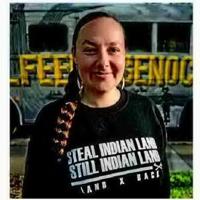Cinnamon Kills First will always remember her first visit to the Sand Creek Massacre site in Colorado.
“It altered my perspective on the world,” she said.
Both Kills First and her late uncle, William Walks Along, are descendants of survivors of the Sand Creek Massacre.
In 1864, on a November morning, U.S. soldiers attacked the lodges of 750 Arapaho and Cheyenne tribal members near Big Sandy Creek in present-day Colorado, resulting in the deaths of an estimated 230 Cheyenne and Arapaho citizens.
Although Kills First learned about the massacre from her uncle, textbooks, and teachers in school, standing at the site itself had a profound impact on her.
“You can sense the energy of a place,” she said. “That’s what stays with you. There’s still a lingering energy. That’s unforgettable.”
People are also reading…
This experience inspired Kills First, a member of the Northern Cheyenne Tribe, to create an immersive theater experience aimed at connecting both Natives and non-Natives with the historical event.
With the support of a National Endowment for the Arts grant, Kills First began hosting immersive theater events related to the Sand Creek Massacre in May.
The initial phase of Kills First’s project targeted non-Native audiences. Participants could purchase tickets for an immersive bus tour with stops at historically significant sites. At each site, audience members and others engaged in recreations of historical events presented by Control Group Productions, a Colorado-based theater organization. Audience sizes ranged from six to 28, with a total of 12 shows hosted by Kills First.
During the tour, attendees on a bus adorned with “Denial Feeds Genocide” stopped at a Colorado Gold Rush site and visited the Riverside Cemetery, where Captain Silas Soule was buried.
Captain Soule, whose family was involved in the Underground Railroad, defied orders and refused to attack the peaceful Cheyenne and Arapaho camp in the 1860s. He later exposed the truth of the army’s brutal attack on a sleeping camp by writing letters to Washington, D.C.
“Any man who participated in the murders under those circumstances was a despicable coward,” he wrote.
In 1865, Soule testified against Colonel John Chivington, the commanding officer at the Sand Creek Massacre. Less than 80 days after testifying, Soule was fatally shot in Denver, according to the National Park Service.
Kills First mentioned that advocates, including her uncle William Walks Along, have used Soule’s writings to advocate for increased awareness of the massacre.
“We’re grateful for his honesty,” she said.
During Kills First’s immersive events on the bus, attendees heard dramatic readings of historical events, placing them in the moment to confront the realities of history.
The bus also stopped at Fort Chambers, a historic site near Boulder where the cavalry regiment trained before heading to Sand Creek. Stops were made at the confluence of Cherry Creek and South Platte River, a significant Cheyenne gathering spot now crowded with commercial establishments like REI and Starbucks.
“The message here is that our access to the land is restricted,” she explained. “The harm continues.”
Lastly, the bus stopped at Larimer Square, where in the 1860s, U.S. soldiers were welcomed home by their families after the massacre. Now a popular spot in Denver, Larimer Square houses outdoor gear stores and coffee shops, unbeknownst to many of its visitors who are unaware of the hidden history beneath the surface.





